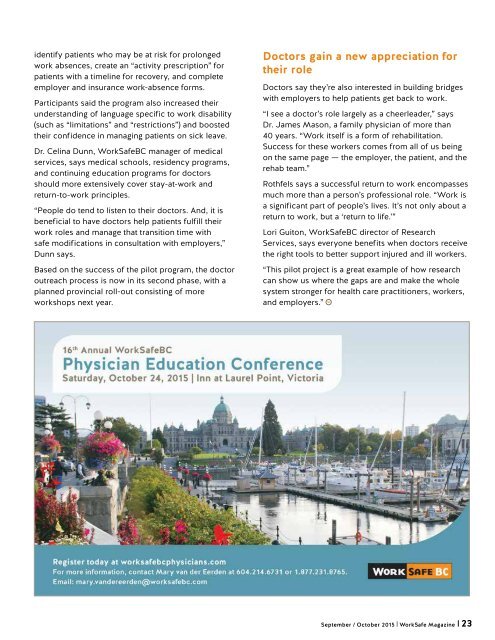WorkSafe
ZUJe3
ZUJe3
You also want an ePaper? Increase the reach of your titles
YUMPU automatically turns print PDFs into web optimized ePapers that Google loves.
identify patients who may be at risk for prolonged<br />
work absences, create an “activity prescription” for<br />
patients with a timeline for recovery, and complete<br />
employer and insurance work-absence forms.<br />
Participants said the program also increased their<br />
understanding of language specific to work disability<br />
(such as “limitations” and “restrictions”) and boosted<br />
their confidence in managing patients on sick leave.<br />
Dr. Celina Dunn, <strong>WorkSafe</strong>BC manager of medical<br />
services, says medical schools, residency programs,<br />
and continuing education programs for doctors<br />
should more extensively cover stay-at-work and<br />
return-to-work principles.<br />
“People do tend to listen to their doctors. And, it is<br />
beneficial to have doctors help patients fulfill their<br />
work roles and manage that transition time with<br />
safe modifications in consultation with employers,”<br />
Dunn says.<br />
Based on the success of the pilot program, the doctor<br />
outreach process is now in its second phase, with a<br />
planned provincial roll-out consisting of more<br />
workshops next year.<br />
Doctors gain a new appreciation for<br />
their role<br />
Doctors say they’re also interested in building bridges<br />
with employers to help patients get back to work.<br />
“I see a doctor’s role largely as a cheerleader,” says<br />
Dr. James Mason, a family physician of more than<br />
40 years. “Work itself is a form of rehabilitation.<br />
Success for these workers comes from all of us being<br />
on the same page — the employer, the patient, and the<br />
rehab team.”<br />
Rothfels says a successful return to work encompasses<br />
much more than a person’s professional role. “Work is<br />
a significant part of people’s lives. It’s not only about a<br />
return to work, but a ‘return to life.’”<br />
Lori Guiton, <strong>WorkSafe</strong>BC director of Research<br />
Services, says everyone benefits when doctors receive<br />
the right tools to better support injured and ill workers.<br />
“This pilot project is a great example of how research<br />
can show us where the gaps are and make the whole<br />
system stronger for health care practitioners, workers,<br />
and employers.” W<br />
September / October 2015 | <strong>WorkSafe</strong> Magazine 23


